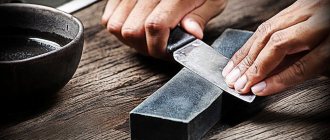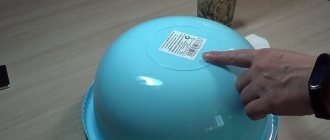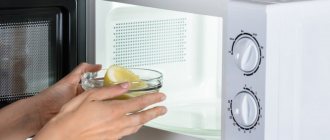A new kettle smells like plastic - a common occurrence for newly purchased household appliances. As extensive user experience shows, getting rid of unpleasant amber is not difficult; just remember all the practical wisdom of household use. An obsessive or subtle odor appears due to various chemical additives that are part of the plastic. The more expensive the product, the better the technical components, the less they emit their specific aroma. There are several ways to quickly and effectively get rid of the plastic smell in your electric kettle.
Cleaning with lemon
This is perhaps the oldest and most popular life hack, and here lemon is used in all forms. The cheapest option is to use regular citric acid; for a standard-sized kettle, one or two packets are enough. The process is not complicated: pour water to the maximum mark, add citric acid and boil. Leave the kettle of lemon water for 12 - 14 hours, boil again and rinse well with running water.
An alternative is to use the juice or peel of three to four lemons. The algorithm of actions will be the same: boil, insist and boil again. It is better to pour water through the spout, this will clean the filter and the outer surface of the plastic.
Important! It happens that a solution of citric acid corrodes parts at the joints. Indeed, a sad fact, but this only happens with low-quality equipment. Good plastic will not deteriorate under the influence of lemon solution, even with regular boiling.
The acids contained in lemon will clean the inside of the kettle and bring metal parts to a shine. The advantage of the method is its absolute environmental friendliness, because lemon does not contain any kind of chemicals and leaves no odor or residue.
How to get rid of it using special compounds?
In cases where treatment with simple home remedies does not help, you can use special preparations. They have a complex effect - they clean the surface, remove dirt and remove unpleasant odors.
The purchase of special products will be justified by the fact that they can be used in the future, during operation, to remove scale.
Topper
To remove scale and provide high-quality treatment, a special product from Topper can be used. The German-made product is gentle on the material from which the device is made, is non-toxic, and does not contain fragrances.
How to use:
- to eliminate the smell, pour a liter of water into the kettle;
- add 100 ml of cleaning agent;
- heated to approximately 50ºС;
- leave for half an hour;
- the liquid is drained;
- the inside is washed with water.
A 0.25 liter package costs on average from 140 rubles.
Top House
The product for coffee makers and electric kettles is designed to remove scale and hygienically clean the internal surface. The consumption of the drug is economical.
Application is very simple:
- Pour a liter of water into the kettle.
- Boil.
- Wait 5 minutes.
- Pour in 150 ml of Top House product.
- Leave for half an hour.
- Pour out the solution.
- Rinse the kettle.
The average price for 0.5 liters is 220 rubles.
Anti-scale agent Magic Power
The product is intended for cleaning the inner surface of teapots and coffee makers that come into contact with water. The product is environmentally friendly, based on citric acid and nonionic surfactants. Manufacturer – Germany. Magic Power for Dummies is biodegradable, has no distinct odor, and is available in liquid form.
Application:
- pour a liter of water into the device;
- add 100 ml of the drug;
- heat the kettle to 50°C;
- set aside for 30 minutes;
- drain the liquid;
- rinse the kettle, and then boil it again with clean water;
- drain the water.
The average price is 240 rubles per 0.5 liter bottle.
Orange zest
A good way to drown out the polymer taste is to treat the inner container with a citrus-flavored liquid.
To do this you need:
- peel 5 oranges, lemons, tangerines or grapefruits (you can make a mix of different fruits);
- to enhance the aromatization effect, it is better to grind the peel in a blender or simply finely chop it with a knife;
- the mixture is placed in a kettle, then filled with cold water to the maximum mark;
- the device heats up to boiling;
- flavored water is left inside for one day;
- the next day, without pouring the liquid out of the kettle, you need to repeat the boiling process;
- After the liquid has cooled, pour it out and rinse the inner flask under running water.
What to do if the smell remains
The smell of plastic can remain even after thoroughly cleaning the electric kettle. If this happened to your electric kettle, then most likely it is made of low-quality plastics. It’s not just models with a plastic body that can smell synthetic. Kettles made of steel, glass, and ceramics can also have an unpleasant odor due to the rubber seals they contain.
If you buy a device from an unverified place, you may end up purchasing a fake that may contain toxic substances. When faced with such situations, the best option would be to take the purchase back to the seller and demand that the kettle be changed to another model or the money returned.
Sugar
Another handy remedy for eliminating the chemical smell in a new kettle is regular sugar with the addition of citric acid. It can be used in two ways.
First option:
- take a full kettle of cold water and boil it;
- after turning off, add 3 tablespoons of sugar with a pinch of citric acid;
- Without turning on the kettle, leave the sweet mixture for 10-15 minutes;
- drain the syrup and rinse the inner walls well with water.
Second option:
- pour three tablespoons of sugar into an empty kettle and leave for 12 hours without adding water;
- after time, dilute half a teaspoon of citric acid in warm water;
- Use the resulting liquid to rinse the kettle of sugar;
- Finally, rinse with running water.
Questionable methods
Some of the methods that are recommended for refreshing an electric kettle do not always give the desired result. Some of the methods given are only suitable for cleaning the device.
Sprite
Carbonated drinks are used to remove scale from the internal walls. But due to the fact that Sprite contains citric acid, this drink can remove unpleasant odors. Cleaning is carried out according to the standard scenario. You need to completely fill the tank with Sprite and boil it three times with an interval of 30-60 minutes.
Activated carbon
You can refresh your electric kettle using activated carbon. To do this, you need to put 15 tablets in an empty tank and, wrapping the device with polyethylene, leave it for a day. After this you need to boil and drain the water.
How to use bay leaf
If you don’t have citric acid or fruits at hand, then bay leaves are present in almost any kitchen. Laurel leaves also do not contain chemical compounds and join the list of environmentally friendly ways to combat the unpleasant smell of plastic in a teapot.
Unlike lemon, laurel quickly gets rid of the aroma of plastic and dyes. Pour half a bag of dried leaves into a kettle, add water and bring to a boil, then let it brew for an hour to an hour and a half. Then bring it to a boil again, drain the water and rinse the kettle.
It is important here to check if there are any pieces of leaves left in the kettle or filter. Even small branches will transmit the spicy scent of laurel to tea or coffee. It would be a good idea to ventilate the device a little after washing.
How to remove plastic odor using improvised means
To remove unpleasant odors, you can use time-tested “grandmother’s recipes.” They are harmless and do a great job. In addition, the process will not take much time, and the result will please you with its effect.
Soda
Regular baking soda, which many of us use in cooking or for heartburn, as well as when washing dishes, works very well for this case. Baking soda is known to do an excellent job of removing many odors.
Operating procedure:
- Pour the maximum allowable volume of water into the kettle.
- Pour in 4 tablespoons of baking soda.
- Stir until the powder is completely dissolved.
- Bring water to a boil.
- Leave in the kettle for 2 hours without draining.
- Boil again.
- Drain the soda solution into the sink.
- Rinse the inside of the electric kettle well.
Lemon acid
Citric acid or lemon juice also does an excellent job of eliminating unpleasant odors, and at the same time removes limescale from old kettles. Method of using citric acid or juice:
- pour water into the kettle to the maximum level;
- pour in 1-2 bags of citric acid or squeeze out the juice of 2-3 lemons;
- bring the water to a boil;
- turn it off and leave it in the kettle for 10-12 hours;
- repeat the boiling process;
- pour out the solution;
- Rinse the kettle well with hot water.
Important! Fresh lemon juice or zest is less effective than citric acid.
Vinegar
Another proven method is to use table vinegar. It has proven itself to be an excellent remover of bad odors and old scale. Progress:
- Pour a glass of water into the kettle.
- Add half a glass of vinegar.
- Add water to the maximum level.
- Heat the water, but DO NOT bring it to a boil and turn off the kettle.
- Leave the solution for 30 minutes.
- We repeat this procedure one more time.
- Drain the solution into the sink and rinse the kettle well.
Bay leaf
Bay leaf or bay leaf, as it is popularly called, can not only add aroma and taste to hot dishes and drinks, but also copes well with unpleasant odors. For this procedure we will need 5-7 medium leaves.
Mode of application:
- Pour water into the kettle to the maximum;
- throw bay leaves there;
- bring the water to a boil;
- leave the solution in the kettle for 3 hours;
- repeat the procedure again;
- pour out the contents and rinse the device well.
After this process, the teapot may smell like laurel, but this is not scary. It is enough to leave it open for a couple of days for the smell to go away.
Sugar
Who would have thought that regular sugar copes well with the problem of unpleasant odors.
Necessary actions:
- Pour water into the kettle to the maximum level.
- Bring it to a boil.
- Add 3 tablespoons of sugar to boiling water.
- Leave the solution for 15-20 minutes.
- Drain and rinse the kettle.
Activated carbon
Activated carbon has proven itself as an effective sorbent. It is widely used in medicine and in agriculture. It copes well with many unpleasant odors. For our procedure you will need about 15-20 tablets, it all depends on the size of the kettle.
Usage:
- Place the tablets in an empty kettle.
- Close the lid tightly and wrap the device in cling film so that it is completely sealed.
- Leave it for a day.
- Remove the tablets and fill with water to the maximum.
- Boil water.
- Then drain and rinse the kettle well.
Coca Cola
Our favorite soda very effectively copes not only with odors, but also with technical oils, which the manufacturer sometimes leaves in the device.
Necessary steps:
- Pour Coca-Cola into the kettle to the maximum level.
- Bring to a boil.
- Turn off the device until it cools completely.
- We repeat the procedure again.
- Pour cola to maximum volume.
- Let's boil.
- After boiling, turn off the kettle to cool down.
- Repeat boiling up to three times.
- Drain the liquid.
- We rinse the kettle.
Soda solution and vinegar for odor removal
Baking soda is a universal household cleaner and a fairly safe one. The use of the usual powder is quite extensive: cleaning dishes, plumbing fixtures, ashtrays from tobacco smell. Baking soda is also useful in combating the “new kettle” aroma. Water, as in previous cases, must be filled to the maximum level. Add 3 – 4 large spoons of baking soda and mix well until the powder dissolves. Bring to a boil once, leave for a couple of hours and boil again.
Baking soda is an alkali, as you know, it perfectly neutralizes acidity, therefore, eliminates various specific odors.
In the absence of soda, vinegar along with vinegar essence will do. Pour 150 ml of 9% vinegar and two tablespoons of 70% acetic acid into a kettle of water. Turn the kettle on and off without letting the liquid boil. After simple manipulations, rinse the container thoroughly.
The main causes of odor
The electric kettle may stink at first or every time it is turned on. Moreover, trouble happens with any equipment, regardless of what it is made of. Most often, plastic produces odor, but stainless steel (steel) and glass also do not guarantee its absence.
Causes of stench:
- Poor quality. If the kettle smells strongly of plastic, this is evidence of its low quality. The manufacturer saved money by using low-quality plastic not intended for food products. Operating such equipment is dangerous, since toxic elements pass into the water and, along with it, into the body. Moreover, the process cannot be stopped, and therefore it is pointless to look for ways to get rid of the smell of plastic in an electric kettle. The device needs to be replaced with a new one. You can use a low-quality item exclusively for technical needs.
- Residues of industrial substances. The manufacture of household appliances is impossible without technological oils. In most cases, their traces remain on the surface.
- Package. An irritating plastic smell can come from the box and polyethylene in which the electric kettle is placed. The longer the product is stored, the stronger the stench.
In addition, kitchen appliances can smell during operation. There are several reasons: poor care of the device (rarely washing the inside), poor-quality water, scale. It happens that the smell appears after several years of use. Under the influence of high temperatures, the plastic case is destroyed, and a stench is released through microcracks.
The smell of plastic may not come from the kettle, but from the packaging
An unpleasant odor from the kettle may indicate poor quality of the product.
Carbonated drinks
Sprite is a highly carbonated lemon-based drink. No matter how funny it may be, it can really remove obsessive plastic odors from a new kettle. The list of suitable sodas also includes Coca-Cola.
Unlike previous methods, here you need to pour in sparkling water instead of regular water and boil it several times in a row, allowing the drink to cool slightly. Next, rinse the container well under running water. In addition to the absence of any odors, the kettle will be well cleaned of any technical liquids, for example, oil residues.
The principle of operation is simple: these drinks contain a component such as orthophosphoric acid (E338). Thanks to this, it perfectly cleans the entire internal surface of the kettle, simultaneously eliminating all unnecessary odors.
What not to do?
Trying to quickly cope with a problem can sometimes make things worse. To prevent this from happening, it is important to remember the following prohibitions:
- The cleaning agent, even in solution form, should not be left on for longer than specified in the instructions.
- Do not use several products at the same time, as this may result in the formation of caustic and toxic compounds. If the previous method did not help, the kettle must be washed thoroughly, and only then continue treatment with another product.
- To combat odors, you should not use products that are not intended for cleaning dishes, for example, room fragrances, eau de toilette, bath cleaners, etc.
Activated carbon
The ability of activated carbon to absorb odors can be useful when eliminating plastic odors in a new kettle. To do this you need to take several sequential steps:
- Place 15-20 charcoal tablets inside the empty device, then close the lid;
- take cling film and tightly wrap the kettle with a lid, leaving no gaps for air access;
- leave the resulting cocoon for one day;
- the next day, remove the film, shake out the coal from the container and pour clean water inside to the maximum mark;
- Boil the kettle and rinse thoroughly after cooling.
Why does the water in the electric kettle smell like plastic?
The reason why your new electric kettle smells unpleasant may be:
- Residues of technical oil that is used in the production of equipment, if it has not been completely removed at the manufacturer.
- Plastic or chemicals that were left in a hermetically sealed bag with the kettle.
- Plasticizers that are added to the plastic from which the kettle was made. Manufacturers add these substances to extend the life of products.
- Cheap dye.
The first two sources of odor can be easily removed by thoroughly rinsing the kettle. The last two are very harmful to health and are almost impossible to remove from the electric kettle.
You should not use an electric kettle if it smells unpleasant and the smell cannot be removed.
If you bought a kettle recently, then you should return it to the store and ask to change the electrical appliance, or get your money back. You are not obliged to use low-quality equipment that may harm your health. Now you know what to do if your new kettle smells like plastic. See also: Removing limescale from a kettle using home remedies
Chemicals
If the means at hand do not help get rid of the obsessive odor, then it’s time to use specialized household chemicals.
Any dishwashing detergent
An inexpensive and effective way to eliminate any foreign odors. In this case, liquid gel, paste or powder for washing dishes is suitable.
Simply apply the cleaning agent to a sponge and thoroughly wash both the internal and external surfaces of the new kettle.
An important point is to thoroughly rinse off household chemicals under running water. To ensure the safety of subsequent use, it is best to test boil the water and then drain it.
Anti-scale products
Such chemicals are sold in any hardware store and help not only remove calcified build-ups in old kettles, but also disinfect the walls of a new device.
Important! For safe use, it is enough to strictly follow the instructions written on the packaging. For allergies, test boiling and draining after cleaning can be done twice.
Refrigerator cleaner with odor neutralizer
An odor absorber, which is often found in refrigerators, can serve a good purpose for a new kettle. Typically, the air purification unit is a plastic container with carbon filters inside. It must be placed in a kettle by analogy with the method of cleaning with carbon tablets and wrapped in film for a day. After a day, return the container to the refrigerator, wash the kettle and carry out a test boil.
Rules for working with household chemicals
When treating food surfaces with chemicals, it is important to adhere to simple rules of protection that do not harm health:
- all products must have a neutral environment that does not corrode the skin;
- You should use only soft powders and gels without adding abrasive particles that can damage the surfaces of food-grade plastic;
- Under no circumstances should you use cleaning products containing chlorine;
- even if the cleaning composition is intended for washing dishes, it is best to work with protective rubber gloves;
- After using any chemical, it is necessary to repeatedly rinse all containers with running water and test boil the kettle.
After using chemicals, be sure to boil the water in a kettle and drain it!
Material of manufacture: what does it affect?
Most often, glass, plastic and metal are used to make electric kettles. There are several reasons for an unpleasant odor from a new electrical appliance, but not all of them can be eliminated.
Technical oils - residues from production
When producing a kettle from any type of material, even at the creation stage, technical oils may get into it . If they were not eliminated upon completion of manufacturing, the pungent odor will continue to persist at the time of sale. Such a nuisance can happen to equipment made from any type of material.
Boiling water in a kettle three times will help solve the problem. The use of home or special remedies will have an even greater effect.
Chemical odor that is not associated with the appliance
After opening the sealed packaging, an unpleasant specific odor may emanate from the new kettle.
This may be due to production air entering the bag before it was sealed. This situation can happen with a kettle made of any type of material.
If the problem arose at the time of packaging, then it will be enough to simply ventilate the product in a room with good ventilation. You can speed up the elimination of odors using homemade and special products.
Plasticizer, dye and other plastic components
A strong and difficult to remove plastic odor very often comes from low-quality devices. This problem is typical for kettles with a plastic body made by a dubious manufacturer.
If the source of the unpleasant odor is the ingredients of the plastic itself, ventilation and treatment will not be able to solve the problem.
Such devices are not recommended for boiling drinking water .
During operation, such a device will release toxic substances into the water, which poses a threat to health. It cannot be used.
Basic operating rules
To prevent unpleasant odors from appearing in the kettle, follow these simple rules:
- Clean the container regularly;
- use clean water after filters;
- do not boil anything other than water in a container;
- If you do not plan to use the kettle for a long time, then rinse it and leave it stored with the lid open.
If you have already purchased a new electric kettle and it has a strong plastic smell, try to get rid of the aroma before you start drinking tea. Drinks that smell like chemicals are unlikely to be enjoyable. As a rule, simple manipulations solve the problem quickly and forever. What to do with the product if technical odors are not eliminated is up to the user: you can return the product to the store or use it for technical purposes.
How to eliminate stench if used incorrectly
Just wash the kettle with soapy water, open the lid and wait a few hours. To prevent unpleasant odors:
- The effectiveness of citric acid in descaling
- Features of cleaning kettles from scale from various materials
- Clean the glass and metal parts of the device at least once a month for preventive purposes. To do this, use a soap solution; just wipe the outside of the glass with a damp cloth.
- Use clean, preferably filtered water for boiling.
- Pour out any remaining liquid at the bottom. Rinse the dishes before adding water.
- If you do not plan to use the kettle for a long time, then pour out the liquid, rinse, dry and store the device with the lid open to prevent the appearance of unpleasant odors.
- Do not boil juices or other liquids.
- Ceramic electrical appliances are safe to use, but heat up much slower than plastic ones. Such products do not have an unpleasant odor. With careful handling of electrical appliances made of ceramics and timely preventive cleaning, their service life increases.











